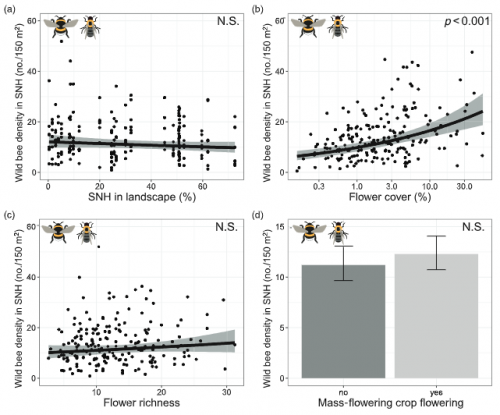Global declines in insect populations, particularly pollinators, have raised concerns about food security, since many crops depend on insect pollination. To address this, various international, national and local initiatives have focused on increasing semi-natural habitats in agricultural landscapes to support pollinators. While increasing habitat quantity has proven effective, the quality of these habitats, particularly flower availability and nesting sites, plays a critical role in supporting pollinator populations. Studies suggest that improving habitat quality may be a more cost-effective and practical solution than simply increasing habitat quantity, but it is unknown whether improving the quality of existing habitats could bring similar benefits without the need of reducing cropland area.
To fill this gap, a partly-funded SHOWCASE paper by partner Wageningen University, analysed the relationships between wild bee and hoverfly densities and the quantity and quality of semi-natural habitats using linear mixed-effects models and data collected in 26 Italian agricultural landscapes during the entire flying season.
The study revealed that at the local level wild bee densities were primarily influenced by flower cover (habitat quality), while hoverfly densities increased with both habitat quantity (semi-natural habitat cover) and quality. At the landscape level, increasing habitat quantity was most effective when habitat cover was initially low, while enhancing habitat quality became more important as habitat quantity increased. The findings suggest that in landscapes with less than 15% semi-natural habitat, increasing habitat quantity is most effective, but in more complex landscapes, improving habitat quality can achieve similar results with less land conversion.
By examining variables such as semi-natural habitat cover, flower availability and the presence of mass-flowering crops, the study predicted pollinator densities and assessed the relative importance of habitat quality versus quantity for supporting pollinator populations at the landscape level. The study presents an approach that can help identify thresholds where improving habitat quality could be as beneficial as increasing habitat quantity, offering insights into cost-effective strategies for pollinator conservation, balancing land use and habitat management to boost pollinator populations.
Read the full paper here.
Image: Average wild bee densities in seminatural habitat (SNH) transects in relation to (a) seminatural habitat cover in the landscape in 750-m radius around landscape center, (b) flower cover (back transformed) in the transect, (c) flower richness in the transect, and (d) whether or not a mass-flowering crop was flowering in the landscape (N.S., not significant; y-axes, back-transformed pollinator densities; points, partial residuals; gray shading, 95% confidence intervals).
